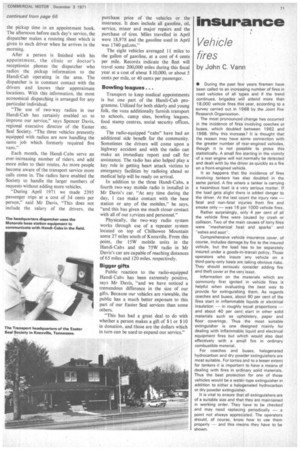insurance
Page 73

If you've noticed an error in this article please click here to report it so we can fix it.
Vehicle fires
by John C. Vann
• During the past few years firemen have been called to an increasing number of fires in road vehicles of all types and if the trend continues, brigades will attend more than 18,000 vehicle fires this year, according to a survey carried out in 1968 by the Joint Fire Research Organization.
The most pronounced change has occurred in the incidence of fires involving coaches or buses, which doubled between 1962 and 1968. Why this increase? It is thought that the reason may have some connection with the greater number of rear-engined vehicles, though it is not possible to prove this statistically. A small fire starting in the vicinity of a rear engine will not normally be detected and dealt with by the driver as quickly as a fire on a front-engined vehicle.
It so happens that the incidence of fires involving tankers has also doubled in the same period. A fire where a tanker is carrying a hazardous load is a very serious matter. If the load gets alight there is added danger to the driver. At the last count the injury rate — fatal and non-fatal injuries from fire and smoke only — was 16 per 1000 vehicle fires.
Rather surprisingly, only 4 per cent of all the vehicle fires were caused by crash or collision. Two of the main causes of lorry fires were "mechanical heat and sparks" and "ashes and soot".
Comprehensive vehicle insurance cover, of course, includes damage by fire to the insured vehicle, but the load has to be separately insured under a goods-in-transit policy. Those operators who insure any vehicle on a third-party-only basis are taking obvious risks. They should seriously consider adding fire and theft cover at the very least.
Information on the materials which are commonly first ignited in vehicle fires is helpful when evaluating the best way to provide for extinguishing them. As regards coaches and buses, about 60 per cent of the fires start in inflammable liquids or electrical insulation — in roughly equal proportions — and about 40 per cent start in other solid materials such as upholstery, paper and floor coverings. Thus the most suitable extinguisher is one designed mainly for dealing with inflammable liquid and electrical equipment fires but which would also deal effectively with a small fire in ordinary combustible material.
For coaches and buses, halogenated hydrocarbon and dry powder extinguishers are most suitable. For lorries and to a lesser extent for tankers it is important to have a means of dealing with fires in ordinary solid materials. Thus the best protection for one of these vehicles would be a water-type extinguisher in addition to either a halogenated hydrocarbon or dry powder extinguisher.
It is vital to ensure that all extinguishers are of a suitable size and that they are maintained in working order. They have to be checked and may need replacing periodically — a point not always appreciated. The operators should, of course, know how to use them properly — and this means they have to be shown.


































































































































